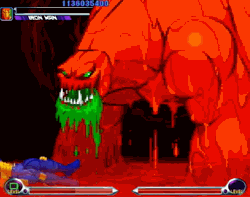 Marvel vs. Capcom 2: New Age of Heroes is an amazing, once in a lifetime game that brings together over 50 characters from wildly disparate worlds and franchises. So, in an effort to pay tribute to one of the games I believe to be the greatest of all time, please enjoy the final day of our five-part, 100% complete, generally alphabetical look at every fighter in Marvel vs. Capcom 2. Now let’s talk about the monkey girl…
Marvel vs. Capcom 2: New Age of Heroes is an amazing, once in a lifetime game that brings together over 50 characters from wildly disparate worlds and franchises. So, in an effort to pay tribute to one of the games I believe to be the greatest of all time, please enjoy the final day of our five-part, 100% complete, generally alphabetical look at every fighter in Marvel vs. Capcom 2. Now let’s talk about the monkey girl…
SonSon
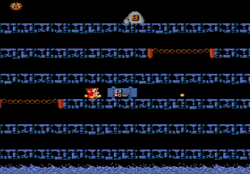 SonSon is one of four original characters in Marvel vs Capcom 2. Amingo, Abyss, and Ruby Heart were all created exclusively for MvC2, and they have not appeared in anything but cameos ever since.
SonSon is one of four original characters in Marvel vs Capcom 2. Amingo, Abyss, and Ruby Heart were all created exclusively for MvC2, and they have not appeared in anything but cameos ever since.
Except SonSon is not an original character. SonSon is based on SonSon from the obscure 1984 Capcom arcade title, SonSon.
Except SonSon is an original character, because she is the granddaughter of that SonSon. She is not the SonSon of SonSon. She is, essentially, SonSon III.
Except SonSon I was not an original character, either. SonSon I was based on Sun Wukong from the 16th century Chinese novel, Journey to the West. SonSon is one of a thousand “adaptations” of this classic tale, with the original premise of Dragon Ball being one of the most prominent illustrations.
So, SonSon III is ultimately an original character that is based on a character that is possibly the least original character in the whole roster.
But, hey, at least she can turn into a giant monkey. That might be better than being a cactus.
Peter “Spider-Man” Parker
And, yes, both franchises subsist on several Young Adult fiction tropes, but very specifically for both cases…
1. The central “Marvel” conflict of Spider-Man was always that Peter Parker kind of sucked as Peter Parker, but excelled at being Spider-Man. Iron Man had his potentially deadly shrapnel that “made him” Iron Man, the Incredible Hulk had his man/monster dichotomy, and Spider-Man had the unbearable burden of having to be a good Peter Parker and superhero. He failed. A lot. Nearly everyone in Peter Parker’s life, from his adopted mother to his boss, thinks Peter Parker is a slacker that is never going to achieve anything, and this is primarily because Pete puts too much of an emphasis on saving the world. He was late because he was stopping a mugging. He missed Aunt May’s birthday because he was dealing with Galactus. It’s kind of a “nice guy” fantasy wherein your every failing has a big, important reason that no one would ever understand because it must be a secret for their own good. But, end of the day, Spider-Man is saving the day, even though J.J. would never believe Peter Parker can accomplish anything. In much the same way, Usagi, Sailor Moon’s “secret identity”, is the world’s biggest screw-up, and if you told her parents that she was destined to rule a thousand years of peace after banishing all evil witches from the land, they would likely die laughing. Very similar “secret identity hijinks” on both sides, with a heavy emphasis on simultaneously being super important but extremely poorly regarded by their friends and family.
2. Similarly, Spider-Man is effectively two different people inside and outside of uniform. Again, a common trope, but this one is central to the character, with Puny Peter Parker rarely capable of defending himself or making the moves he needs to make, while Spider-Man routinely quips his way through battles that would scare off seasoned warriors. And, while you could claim that Sailor Moon is still “crybaby Usagi” in a lot of combat situations, that same “crybaby Peter Parker” was a lot more prominent in early (like pre-90s) Marvel comics. Spider-Man just happened to have a running, internal monologue conveyed through thought balloons about how much he was concerned about peeing himself while hopping around Green Goblin, while Sailor Moon has to “reveal” she still has issues in more immediately obvious ways for the audience. In both cases, you have a character that generally projects confidence after their “transformation”, but is still the same person underneath it all.
3. In both cases, the “crybaby” superhero is continually confronted with people who are “better” at being heroes, often because the other heroes are somehow veterans of the new and emerging field of monster/villain extermination. Spider-Man tried out for/failed to impress the Fantastic Four in the first issue of his self-titled series. To this day, Spider-Man media seems to set the hero as a “protégé” in random stories, most notably with his relationship to Iron Man in the MCU (and that was theoretically based on a similar dynamic in the comics), despite Spidey being very established both inside and out of his universe(s). Similarly, Sailor Moon is literally the titular character, but both Mars and Mercury join and are immediately identified as “better” Sailor Scouts by that talking cat. Later, Sailor Venus, Sailor Uranus, and Sailor Neptune all sign up with varying degrees of “we’ve been doing this longer, and we’re pretty good at it” positions. And, in all these cases, this happens after Spider-Moon has a victory count starting in the double digits, and quickly climbing to somewhere in the hundreds. They are good at what they do! They do it every week! But people keep saying they are better than them! Show me the proof! Having a cool sword doesn’t count!
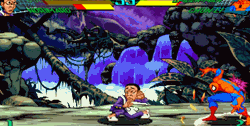 4. They both exist in a very deliberate character stasis that means they are somehow teenagers that have histories that are longer than the lives of most of their audience (and you can’t tell me that modern Spider-Man, in all incarnations, is not written like a teenager). There is always that epiphany that lets them overcome their latest mental hang-up, and they are always going to have a similar mental breakdown a whole two episodes/issues later. Peter Parker can be the focal point of the multiverse, “graduate” to teaching at a public school, and save the world… but he’ll be back to working at the Daily Bugle and worrying about paying Aunt May’s rent in a month. Sailor Moon has pink-haired living proof that she is going to be the queen of the world and marry the man of her dreams, but she gets de-aged like one time, and she’s ready to never leave her room again. There is never going to be enough change for either of them, so you know you are looking at the same ol’ problems all over again when they pop up.
4. They both exist in a very deliberate character stasis that means they are somehow teenagers that have histories that are longer than the lives of most of their audience (and you can’t tell me that modern Spider-Man, in all incarnations, is not written like a teenager). There is always that epiphany that lets them overcome their latest mental hang-up, and they are always going to have a similar mental breakdown a whole two episodes/issues later. Peter Parker can be the focal point of the multiverse, “graduate” to teaching at a public school, and save the world… but he’ll be back to working at the Daily Bugle and worrying about paying Aunt May’s rent in a month. Sailor Moon has pink-haired living proof that she is going to be the queen of the world and marry the man of her dreams, but she gets de-aged like one time, and she’s ready to never leave her room again. There is never going to be enough change for either of them, so you know you are looking at the same ol’ problems all over again when they pop up.
5. Despite being household names now, Spider-Man’s initial rogue’s gallery was a collection of big “generals” (Doc Ock, Green Goblin), and then many more villains that were just whatever happened to be on this year’s animal-of-the-month calendar. The Vulture! The Rhino! The Scorpion! The Vermin? A… dude… who… wears animal pelts? The… Spot? Crap, that was just where Stan Lee circled his cousin’s birthday. Oh well, run it anyway. You can’t tell me Sailor Moon’s monsters-of-the-week don’t come from the same basic inspiration of “wouldn’t it be cool if this week’s villain had a tail?”
All that said, obviously Sailor Moon was a huge influence on any future Magical Girl media. So, if that all traces back to Spider-Man in the first place, I really want Peter Parker to be recognized as a magical girl. He’s been trying so hard. He even has a magical costume transformation now! It was in the trailer for Spider-Man: No Way Home!
Rita Wayword aka Spiral
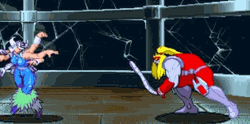 Rita Wayword was a professional stuntwoman that fell in love with the wrong boy (Longshot), wound up ensnared in a temporal paradox, and yada yada yada now she has a cool helmet and six arms. Spiral was modified to have extreme magical powers, significant surgical knowledge, and the ability to teleport around and telekinetically toss swords just to spice things up. This is all in the service of Mojo, a literally spineless being that rules all of Mojoworld (in the Mojoverse), a planet that is all about its cable TV and 72,000 channels.
Rita Wayword was a professional stuntwoman that fell in love with the wrong boy (Longshot), wound up ensnared in a temporal paradox, and yada yada yada now she has a cool helmet and six arms. Spiral was modified to have extreme magical powers, significant surgical knowledge, and the ability to teleport around and telekinetically toss swords just to spice things up. This is all in the service of Mojo, a literally spineless being that rules all of Mojoworld (in the Mojoverse), a planet that is all about its cable TV and 72,000 channels.
And if you have ever seen Mojo, you know the “gag” of Mojo: he is an evil television executive, and his every appearance is an opportunity to poke fun at the whole of the television medium. It is comics calling television stupid. It is pictures on a page with word balloons pointing towards those newfangled talky boxes and saying, “TV rots your brains!” And every time an X-Men writer comes up with an idea that is too ludicrous for comics (X-Babies! The X-Men as a reality show!), they can just toss Mojo on it, and claim that it is a tongue-in-cheek look at that other medium. Comics are high literature, children, and television is stupid.
And, while Mojo is a focus on how comics tend to point and laugh at television’s “idiot box” moniker, this is something that happens across all epochs and mediums. The first X-Men movie took time to mock the “yellow spandex” of its comic origins, and the recent Wandavision still had to insult the very concept of Wanda’s OG costume. Novels are continually tossing shade at “lesser” movie adaptions, and dang near every medium can find time to make fun of streamers, influencers, and the new entertainment of the information age. Hell, even specifically related to this article, the Spider-Verse crossover took a page out of its busy schedule to have its big bad kill the Spider-Man of the Marvel vs. Capcom universe in a “perfect victory”. Considering how many other Spiders got out alive across that series, that did feel like an indictment of the “silly” medium that wouldn’t stand a chance in a real comic crossover. It has gotten to the point that it is an absolute rarity to see a medium actually compliment another medium and encourage putting down a book to see a movie, or vice versa.
Well, except Space Jam: A New Legacy. That is a movie about a sports star going to a cartoon world to play a videogame, and every medium involved compliments everyone else. Movies are good. Sports are good. Cartoons are good. Videogames are good. The ultimate moral seems to be enjoy what you want to enjoy, and Bugs Bunny can be found in all sorts of places. Space Jam 2 is a cold, calculating multimedia umbrella that forgot it was ever supposed to be funny, but it is at least tolerant of its every addressed medium or hobby. And can you think of another movie, comic, videogame, or book that does that?
Mojo might stay relevant if he can start producing a few shows like Space Jam: A New Legacy. And, hey, a few Space Jam Goons already look like Spiral …
Ororo “Storm” Munroe
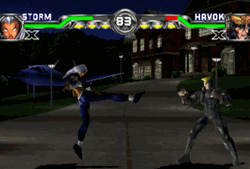 So how do mutants get out of bed in the morning?
So how do mutants get out of bed in the morning?
You’ve got mutants like Doug Ramsey, right? Dude can immediately understand any language, and that’s his whole deal. So, while he can “understand body language” or something to fight in a pinch, he knows his real niche, and that is as a dedicated translator. If you need to talk to the Japanese investors or a living island as old as the Earth, you’ve got Doug, and he can handle it. Similarly, there’s Japheth aka Maggot, and his living, crawling digestive system that can eat anything and psychically learn about its meal, so you want Maggot on the team when you have found something mysterious, but relatively tasty. In short, there are mutants that have clear, well-defined powers with simple uses. You need to teleport somewhere? Fine! Call the blue guy, and call it a day.
And then there are mutants like Storm. Storm can effectively do anything.
Storm was an orphan thief. Then she gained her powers, and was worshipped as a goddess. She stepped down from divinity to join the X-Men, and even led them for a time completely without powers (Cyclops finds that job impossible with superpowers). She led the Morlocks. She was queen of an entire nation. She is often headmistress of a school. She has been a leader of men, women, and whatever Warlock happens to be. She is a strong, amazing woman. And, oh yeah, she can command the very weather itself.
And, Jesus, what do you do with all of that?
I have enough anxiety about whether I should spend my time playing videogames (fun!) or doing laundry (boring!). I know I should be “adulting”, but I need a little me-time right now, and if that involves Final Fantasy, so be it. But Storm? She can control the weather. She can channel thunder through her hands. She can commune with trees on occasion (look it up!). She can literally feel and change Nature (absolutely with a capital “N”). She can make life exactly like a hurricane (woo hoo), and bring green to a desert. She can do nearly anything with her powers, and that is before she grabs Stormcaster and becomes a verified goddess.
So how does she do it? How does she justify hurling lightning at the toad man when she could be reviving an entire continent? Oh, her powers only impact an area temporarily? Well, I am pretty sure one storm’s worth of rain could keep a village rolling in baths for a solid month or so. Just take a day for each arid region, and, when you’ve reached the end, start back at the beginning. Tell me that wouldn’t be more worthwhile than fighting a mutant with “is chubby” powers for the seventeenth time. Trust me, Marvel Girl can handle this dork, go do some real good.
And do not even get me started on a woman who can generate a current at will. Did Professor X recruit her to save on the X-Mansion electric bill?
So congratulations to Ororo Munroe, the super woman that can somehow play through a game of baseball with a smile while knowing full well she could be solving world hunger. Better you than me, Storm.
Strider Hiryu
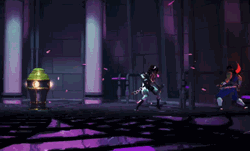 Strider is the title given to a few ninja throughout the Capcom universe. There have been at least two official Striders thru a solid thousand years of continuity, and, recently, the Street Fighter 5 character Zeku was heavily implied to be the originator of the Strider “style”. Strider Hiryu of Marvel vs. Capcom 2 is just one Strider in a line of many.
Strider is the title given to a few ninja throughout the Capcom universe. There have been at least two official Striders thru a solid thousand years of continuity, and, recently, the Street Fighter 5 character Zeku was heavily implied to be the originator of the Strider “style”. Strider Hiryu of Marvel vs. Capcom 2 is just one Strider in a line of many.
And, as there are Striders, there must be a definition for what a Strider “is”. Apparently harkening back to the literary origins of a ninja, a Strider is a professional expert in sabotage, stealth, and subterfuge. A Strider is meant to live in the shadows, the margins of the world, and reveal themselves only when absolutely sure they can strike with the inversely deadly precision of a surgeon. Striders are even aided by the likes of trained (robot) birds and dogs, both enormously adept at aiding in reconnaissance and the skill to be unseen for generations. Striders exist primarily as myth, because the only people that have seen them in the flesh were immediately separated from their own flesh.
Except Strider Hiryu.
Strider Hiryu constantly runs forward, slices through hundreds of humans/robots/humans-that-are-robots, and occasionally slaughters an entire Russian parliament (that may or may not have been a flying centipede). He wears a bright red scarf, leaps around in broad daylight, and then slashes at an enormous, robotic tyrannosaurus. Do you think someone saw that, Hiryu? You think maybe someone caught that moment when you so publicly saved the world from a space wizard, it was talked about for a thousand years?
You blew it inside of three generations, Hiryu. Way to obliterate the mythical standing of a whole organization for a friggen millennia. You wanna just save some time, and make your Facebook page public next time? Strider Hiryu is sending you a friend request!
Thanos
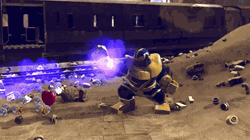 Screw it, I want to complain about cinema. Spoilers for Avengers: Endgame, a film that premiered two years ago, are to follow.
Screw it, I want to complain about cinema. Spoilers for Avengers: Endgame, a film that premiered two years ago, are to follow.
And, incidentally, I apologize if you have not seen Avengers: Endgame. I am predicating much of this article on the fact that the general public is familiar with a number of these characters thanks to the Marvel Cinematic Universe. Captain America may have always been a household hero (probably something to do with the name) while Thanos was never the center of the Marvel Universe. But now? Everybody knows that grape-colored titan that had a plan to drastically cut down on property values by cleaving the population in half.
In the comics, the tale of Thanos courting Death was a lot more literal, and had to end with magical wishing rocks returning Hawkeye to his former glory. But, more importantly, righting Thanos’s wrong incidentally erased the memories of every mundane soul living or dead. Big crossover where half the universe died, but it ultimately did not have ramifications on every facet of life, because power gems gonna power. In the MCU, though? Nope! Everybody remembers “the snap”, and there are big, adult consequences to people being dead and then undead all over the place. Recent MCU output (currently available on Disney Plus for only $7.99 a month!) has confirmed that there are going to be ongoing developments as a result of half the population taking an existential half a decade off, and, while Thanos may have been defeated and his plans undone, there are still going to be capital-C Consequences for the rest of time (stone).
But how are we supposed to take that permanency threat seriously when the “origin” movie for all this nonsense perverts its whole message inside of two hours?
The opening of Avengers: Endgame was amazeballs because it was in no way amazeballs. After a year of every nerd on the planet discussing, debating, and throwing dirty emojis at exactly who and how Thanos would be defeated, Thor decapitates his hated foe in an act that is ultimately meaningless. Thanos won at the end of Avengers: Infinity War, and “avenging” would not change that. Thanos barely puts up a fight! He was the victor, but he has been defeated by his own victory. He destroyed the infinity ladder he used to climb to such heights, and when his victims come calling, he is defenseless because he did not want to leave even a chance that they could use his previously utilized power against him. There is probably a metaphor there!
And, in much the same way that Thanos is “done” after his victory, the heroes are similarly withdrawn immediately after defeating Thanos. Some heroes, like Captain America and Black Widow, keep fighting the good fight. But Hawkeye becomes some manner of vengeance demon, while the likes of Thor and Hulk effectively retire from the heroing business. And that’s real! That’s honest! No matter what the Avengers could do to defeat Thanos, he had already won, and there is nothing in a linear universe that they could do to reverse that! There would be no gigantic battle, no “infinity war”, there was simply people that failed to stop a disaster, and punishing the root cause of that disaster would do nothing to change the past. There is probably another metaphor there, too!
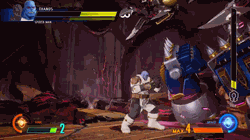 And then the Avengers find a way to right what once went wrong. And that was always expected, right? You cannot just leave half the universe (and, more importantly, Spider-Man) dead; you must find a way to make it right. This new victory will save the world, but it will not change what happened to the heroes that earned it. Black Widow will still make a sacrifice, Hawkeye will still be tainted by his retribution, and Thor will still need to find a personal trainer, but at least families will be reunited. Pretty typical “Act 3” here: the heroes turn it all around and are worse for it, but the world is better. Tale as old as time.
And then the Avengers find a way to right what once went wrong. And that was always expected, right? You cannot just leave half the universe (and, more importantly, Spider-Man) dead; you must find a way to make it right. This new victory will save the world, but it will not change what happened to the heroes that earned it. Black Widow will still make a sacrifice, Hawkeye will still be tainted by his retribution, and Thor will still need to find a personal trainer, but at least families will be reunited. Pretty typical “Act 3” here: the heroes turn it all around and are worse for it, but the world is better. Tale as old as time.
Except a magic rock-based clip show doesn’t make for an entertaining finale to over a decade’s worth of movies, so maybe we could slide a war in there at the end. And who better to lead the enemy army than Thanos, the ultimate bad guy of so many end credits sequences? Who cares if we already killed him? We want catharsis!
And thus did Avengers: End Game end with an epic battle against not only a time-displaced, fully revived Thanos, but a Thanos that is at the absolute height of his powers. All the heroes were able to work together, throw around some legendary hammers, and triumph over Thanos in a completely satisfying way. No “retired old farmer” Thanos here. Now we have an intergalactic warlord that apparently could have been defeated one movie back if everyone had been cooperating 100% (and had a techno-gauntlet, too). Remember that “meaningless” avenging earlier in the movie? And how it sucked? Well now it is awesome! Spider-Man is there! This battle is L I T.
And I cannot imagine a bigger thematic/narrative cheat than killing the same guy twice. Didn’t feel good about the first effort? Well here you go. Now a pyrrhic victory is an uncontested joy for everybody involved (except that Tony fellow), and you can walk away happy. Ding dong, the witch is dead, and it is all thanks to our heroes being smart and clever and oh so handsome.
So you want to tell me the Mavel Cinematic Universe is going to be more beholden to consequences than its comic origins? Get out of here. Thanos is a shining example of how they will literally rewrite time and space to have a cool third act.
And sorry, Thanos, we don’t need you anymore. Looks like Disney already has enough bloodthirsty sadists in its employ.
Tron Bonne
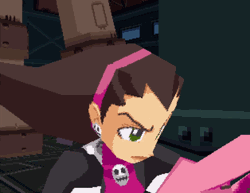 Tron Bonne is the rival of MegaMan Volnutt, and, arguably, the most recognizable character from the Mega Man Legends franchise. She is a pastiche of typical Japanese anime villains, like Doronjo of Yatterman, or Princess Devilotte de DeathSatan IX (wait…). She performs villainous actions, but fails so often that she ultimately proves to be more effective at helping the good guys… even if she will publicly object to being supportive. And, in this case, the Mistress of Servbots even has the added personality quirk of having a crush on the dog-banishing hero, thus guaranteeing a romantic rivalry with Roll Caskett, MegaMan’s “girl next store” love interest. With so much story potential, it is no wonder she appears in more games than the “leading” MegaMan Volnutt.
Tron Bonne is the rival of MegaMan Volnutt, and, arguably, the most recognizable character from the Mega Man Legends franchise. She is a pastiche of typical Japanese anime villains, like Doronjo of Yatterman, or Princess Devilotte de DeathSatan IX (wait…). She performs villainous actions, but fails so often that she ultimately proves to be more effective at helping the good guys… even if she will publicly object to being supportive. And, in this case, the Mistress of Servbots even has the added personality quirk of having a crush on the dog-banishing hero, thus guaranteeing a romantic rivalry with Roll Caskett, MegaMan’s “girl next store” love interest. With so much story potential, it is no wonder she appears in more games than the “leading” MegaMan Volnutt.
But, then again, maybe that was inevitable. The Mega Man franchise has been going strong (more or less) since 1987. That’s almost 35 years of super robot fighting! And in that time, all of its female characters have been… Roll.
Roll is Mega Man’s robotic sister. He fights, she stays home and cleans. In later games, she was granted something of a “spotter” role, and occasionally manned the upgrade shop that kept Mega Man rolling in charge lasers. In the whole of the original Mega Man series, there were only ever two other women: Dr. Cossack’s practically anonymous daughter (Kalinka), and Splash Woman in the 2008 revival. Other than that… Well… Let’s just say there are about 120 Robot Master Weapons, and exactly one comes from a woman.
And the rest of the spinoffs? Mega Man X prominently features Iris, who is “what if Roll had a really bad day” (complete with noxious sibling fixation!). She was replaced by Alia, who did all that boring spotting, but never grew enough of a robo spine to get off her butt and pilot a purple bat mech (hidden characters and gachas don’t count!). She was joined in Mega Man X8 by two other spotters with similarly massively passive personalities. Further down the timeline, we had Ciel (“What if Roll was a girl boss?”) in Mega Man Zero, and Fairy Leviathan, who only marginally qualifies as original, as she was literally a clone of another (male) character. Mega Man ZX and ZX Advent gave us a few heroic women… but it was very easy to play through a version of those games where they effectively never existed. Do bold women count if they are optional? Off in another dimension, Mega Man Battle Network gave us a greater variety of women, but not a single one stole the spotlight from the boys (even if Roll.EXE was at least battle ready). Greater portfolio, same pile of milquetoast nonentities.
And the other woman besides Tron in Mega Man Legends was literally Roll. There are expectations there!
About the only other character that appears in a prominent role and gets away from the Roll Archetype in the Mega Man universe is Luna Platz of Mega Man Star Force. Sonia becomes little more than the new Roll.exe after her Persona-esque opening vignette, but Luna maintains her edge even after “getting over” her alien-inflicted personality problems. She has a tsundere relationship with Geo! Like Tron! Unfortunately, she does not get to be nearly as active as Sonia, and, though she at least maintains… dammit! Support! She’s another supporter “Roll”! Consarn it!
Is it any wonder that Tron Bonne is the only Mega woman to make a splash outside of her own franchise? Is it remarkable that she is more popular than her leading man? She is unique in the whole of decades of Mega Man Lore! And she has an army of robo-minions! Fans know that if anyone is going to get a stranded hero off the moon, it’s gonna be Tron.
Eddy “Venom” Brock
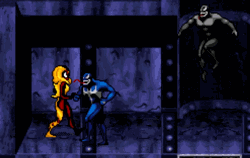 Retcons are a natural part of comics. Comic books are written by multiple writers through multiple epochs, and it is inevitable that something that may have been accepted twenty years ago now needs to be changed for modern audiences. Couple this with a number of comics being curated by absolute sex maniacs, and it is no wonder that Disney Corp. may occasionally ask a writer to tone down the overt S&M fueling any given X-Men comic. Or, once you move past corporate overlords, you have the simple problem of popularity. Maybe a villain you designed for one issue inexplicably becomes fashionable, so a final-page death must be hastily retconned to “that didn’t happen, he’s fine.” Or perhaps your villain rides that same wave of popularity to his own series, and you can’t just have the villain be a bad guy for a hundred continuous months of shared continuity, so you have to tone down his more wicked behavior. And maybe some of that behavior involves, ya know, cannibalism.
Retcons are a natural part of comics. Comic books are written by multiple writers through multiple epochs, and it is inevitable that something that may have been accepted twenty years ago now needs to be changed for modern audiences. Couple this with a number of comics being curated by absolute sex maniacs, and it is no wonder that Disney Corp. may occasionally ask a writer to tone down the overt S&M fueling any given X-Men comic. Or, once you move past corporate overlords, you have the simple problem of popularity. Maybe a villain you designed for one issue inexplicably becomes fashionable, so a final-page death must be hastily retconned to “that didn’t happen, he’s fine.” Or perhaps your villain rides that same wave of popularity to his own series, and you can’t just have the villain be a bad guy for a hundred continuous months of shared continuity, so you have to tone down his more wicked behavior. And maybe some of that behavior involves, ya know, cannibalism.
The Venom Symbiote was first introduced when Spider-Man went to precisely the wrong robotic tailor during Secret Wars, and gained a black, sentient costume. It enhanced all of Spider-Man’s powers, and allowed for some handy dandy camouflage whenever he wanted to impersonate Aerosmith. Unfortunately, Peter Parker had overwhelming white guilt (and regular guilt) over inadvertently enslaving what he eventually learned to be a sentient being, so he tore off the symbiote, and it attached to one Eddy Brock. Eddy was a surly sort who blamed all his problems on Peter Parker and Spider-Man, so when he suddenly gained spider-powers from this discarded attire, he became a sort of Anti-Spider-Man (with the added benefit of a rad visual motif). Spider-Man is all about accountability, so what if he had all the power, but none of that responsibility? Venom is the answer. Venom is the monster that Peter Parker could be.
Oh, and he eats people. Not certain if that is a play on the whole spider thing, but… yep, totally eats people.
And ever since the 90’s, Eddie has been having his pet Klyntar morph into a top that reads, “No, I never ate people,” that has his audience asking a lot of questions already answered by the shirt. No matter the series, no matter the writer, some rando always takes the time to point out that Venom used to eat people, and Eddie Brock is quick to say, “No no, that was a misunderstanding!” But it wasn’t! Some of us were reading comics in the 90s, and we knew the, like, whole deal was that Venom worked on vague, zombie-esque rules. He had to eat people! He was just eating bad people! And if you think this is our collective memory playing tricks on us, consider Iron Man #302, where Venom attempts to eat a Tony Stark that turned out to be a robot. Or a similar situation in Venom: Sinner Takes All #3. Or an equally robotic “edge case” in Venom: The Mace #3 (weirdly, lotta threes here). And there was Venom: The Hunger in ’96, and, let me tell you, there is a reason that trade paperback is not called Venom: The Satisfied and Does Not Need to Eat Out of Anyone’s Skull Right Now.
It is understandable. Venom has gone from a villain that doubled as a metaphorical rape demon (ask M.J. Watson-Parker how she feels about her first encounter with Eddy), to an anti-hero who had to use his curse for good, to a grumpy good guy who had to have his own antagonistic evil twin(s) (see Carnage, Venom-Scorpion, or anytime Dr. Doom sticks a symbiote on a t-rex). It is understandable that a number of those early, creepy inclinations would have to be ironed out over the years. Unfortunately, it is hard to ignore freaking eating people, and now Eddie has to start an apology tour every other month for all that brain matter floating around his digestive track. It was an accident! That mugger was just too delicious!
Oh, and Marvel vs. Capcom 2’s Venom is forever commenting that they want to eat your brains. That probably isn’t helping matters, either.
James “War Machine” Rhodes
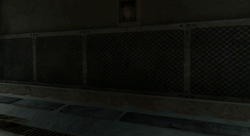 What follows is an actual conversation I had with a pair of my “nephews”. Names changed to protect the innocent.
What follows is an actual conversation I had with a pair of my “nephews”. Names changed to protect the innocent.
“Look, Older Brother! I made an Iron Man!”
“Younger Brother, that can’t be Iron Man. That action figure is black. Iron Man is white.”
“Yuh-huh, Big Brother! If Captain America can be black, so can Iron Man!”
“That’s not how it works, Younger Brother!”
“Actually, children, Iron Man was black for a while in the comics. Tony Stark was having troubles with drinking too much, so his buddy James Rhodes took over as Iron Man.”
“Who is James Rhodes, Goggle Bob?”
“He’s the black guy in the Iron Man movies. He was War Machine and Iron Patriot. He was the hero that got hurt in Civil War? He was mostly played by the bad guy from Space Jam 2.”
“Okay, but he never became Iron Man in the movies?”
“Yeah. He was just always War Machine, never got to actually be called Iron Man.”
“Okay, so… why? Isn’t Iron Man dead now? Can’t ‘James’ be the new Iron Man?”
“Well, yeah, technically, I guess. Doesn’t seem like they are doing that, though.”
“But why not?”
“I don’t know. Robert Downey Jr.’s contract?”
“But he’s dead!”
“No, the actor is still alive. Iron Man died.”
“So why does Iron Man’s contract still control things? Why can’t we have a black Iron Man!?”
“Sweet, summer child. Disney contracts will still control this world long after we’re all dead. Don’t fight it.”
And then they went back to arguing about who got to play Splatoon 2.
James “Wolverine” Howlett aka Logan
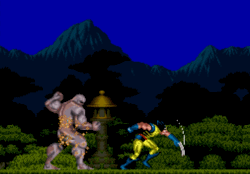 The X-Men are a metaphor. Many of the Marvel superheroes are, ultimately, privileged. It is obvious that Tony Stark is a craptillionaire or Dr. Bruce Banner is a prestigious scientist, but even “street level” heroes are often fortunate sons. Peter Parker has a family he can always fall back on for help, and he seems to be accepted by (white, male) authority figures almost universally and instantly. The Thing is a chunk of living rock, but he has his own local Yancy Street gang, and that would be a very different situation if his skin was black instead of orange. Marvel heroes may have problems, but they are still generally white dudes doing pretty alright in the grand scheme of society.
The X-Men are a metaphor. Many of the Marvel superheroes are, ultimately, privileged. It is obvious that Tony Stark is a craptillionaire or Dr. Bruce Banner is a prestigious scientist, but even “street level” heroes are often fortunate sons. Peter Parker has a family he can always fall back on for help, and he seems to be accepted by (white, male) authority figures almost universally and instantly. The Thing is a chunk of living rock, but he has his own local Yancy Street gang, and that would be a very different situation if his skin was black instead of orange. Marvel heroes may have problems, but they are still generally white dudes doing pretty alright in the grand scheme of society.
But the X-Men are different. No matter what comes down the pike in the Marvel Universe, from space gods to Hydra conquering the planet, the X-Men are the “others” of the heroing community. They represent mutant-kind, and are always going to be distrusted. If some legendary firebird is coming to town, the populace wants Captain America to have it, not Cyclops. If everyone has to battle on a world built for battlin’, it’s the X-Men that are forced to form their own third column. Do you know how many times Marvel’s Mightiest Mutants have had to create their own isolated, island nation? It is many more times than you would think.
But this works, because the X-Men are a simple metaphor for the “others” in our own society. The metaphor does not always 100% fit (historical documents have gotten kinda sketchy recently, but I am almost certain Martin Luther King Jr. did not have fire breath), but the concept is baked into the X-Men’s DNA (literally!), and influences how the characters consistently act. Scott Summers and Matt Murdoch (aka Daredevil) both have disabilities, but there is no way Slim would have ever gotten through law school to have a chance at Matt’s day job.
So where is Wolverine in all this?
We can easily see the most prominent X-Men in this metaphor with their associated roles. Professor X has often been compared to the Ghandis and MLKs of “minority movements”, so that is a pretty well-trodden archetype in reality and fiction alike. Similarly, Magneto is often associated with the more overtly “militant” factions, for good or ill. From there you have characters like Scott Summers and Jean Grey, who could conceivably “pass”, but are heroic because they choose to fight for their less accepted brothers and sisters. And any of the “weird colored skin” mutants obviously fall into the most significant racist groupings, complete with characters like Beast that gradually slide more and more into otherness as time passes. And there can even be great sub-metaphors with that structure! Nightcrawler is a deeply devoted Christian that must reckon with the fact that a number of people that share his faith literally want to murder him. That’s solid gold!
Wolverine is something else. He is the best at what he does, and what he does ain’t pretty, but is what he does anywhere in service of the reason we have the X-Men? A number of fans believe that the X-Men did not really satisfy its premise until it dropped the all-white, all-pretty original cast for the Giant-Size X-Men #1 team featuring the likes of Storm, Thunderbird (for 4 seconds), and Wolverine. But Wolverine was definitely the whitest of the new hires (Colossus had the decency to have metal skin half the time), and “Canadian” is not exactly on the same “hated and feared” echelon as other nationalities. And never mind the fact that Wolverine has amazing skills and powers. He is immortal! Unkillable! With immediately accessible, omnipresent, cool weapons. And smells great! And apparently speaks every language ever, despite way too much amnesia to mention! Wolverine is a minority, yes, but he is only in the minority because he is the absolute greatest and most wonderfullest creature on the planet. There can only be one Wolverine! (Except all those times there are other Wolverines.)
But is that the point? Maybe Wolverine’s place in the metaphor is that he is the ultimate. Nick Fury wants to recruit Wolverine for S.H.I.E.L.D. The Avengers have been finding a place for Wolvie for the last two decades. Every last X-Men team seems to include their clawed champion, and he still finds the time to swing by multiple (non-mutant) teen teams to mentor the young’uns. In the real world, Wolverine holds the record for appearing in the most comic books in a given month. He is the most popular Marvel hero in their entire comics universe!
And he is a mutant. He is an other. He is the best of them, and he isn’t even “of them”. He is exactly who they are supposed to hate, but he is someone they love. And they may make comments, they may call him out on occasion, but they still beg for him to be with them, and never against them.
He is the best at what he does, and what he does is make us realize that an “other” can be the best.
Wolverine (a separate, clone character, but with bone claws)
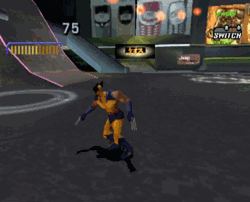 Did you know that an original intention for Wolverine was that he was to be revealed as a mutated, biological wolverine animal that had become generally human shaped? Wild, right? Like, he was just supposed to be some beast dude, who, like, forgot he was an animal? Totally not remotely human? Make it super weird for his various lovers? Basically, the point is that Wolverine isn’t just furry, he is his own fursona.
Did you know that an original intention for Wolverine was that he was to be revealed as a mutated, biological wolverine animal that had become generally human shaped? Wild, right? Like, he was just supposed to be some beast dude, who, like, forgot he was an animal? Totally not remotely human? Make it super weird for his various lovers? Basically, the point is that Wolverine isn’t just furry, he is his own fursona.
Zangief
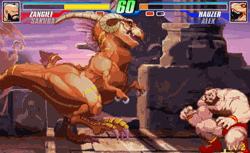 Never underestimate the power of revising a decent idea.
Never underestimate the power of revising a decent idea.
Zangief is one of the most iconic Street Fighter characters. He has appeared not only in multiple fighting games, but also media far outside his original domain, like the Disney film Wreck It Ralph. In much the same way that Ryu and his dragon punch have defined all other fighting game protagonists, Zangief is often noted as the ur-grappler. He is the “wrestler-type” character that all other fighters, from Iron Tager to Incineroar, must compare themselves. Even his signature move, the spinning piledriver, has been emulated countless times across many fighter, but the OG Red Cyclone remains its king.
But Zangief is not all that original to begin with. It is clear Zangief was partially based on Mayor Mike Haggar of Metro City and the Final Fight franchise. Their similarities are myriad, and it is hard to argue that a character from Final Fight, the franchise that inadvertently started as a Street Fighter “spin-off”, would not be known by the creators of the Street Fighter 2 cast. And this connection between Zangief and Haggar has been acknowledged in later sources, from overt references in Muscle Bomber: The Body Explosion to more subtle, hinted connections between the two wrestlers. Even the seemingly ironclad rule that Haggar and Zangief cannot appear in the same game highlights how the two are far too similar to share a screen.
So, since Haggar came first, it is accurate to say that Zangief is based on Haggar. So, what was going to be unique about Zangief at his inception? Well, he was always going to be from the U.S.S.R., and, given the Cold War that had been going on for decades at Street Fighter 2’s release, that would have made him a clear rival to the U.S.A.’s Guile. Since that was supposed to be Guile’s starring premiere, this would have firmly positioned Zangief on the bad guy’s side. Additionally, the name Zangief (likely heisted nearly unchanged from real-life pro wrestler Victor Zangiev) was not his original moniker. The initial name for “rival” Zangief was… Vodka Gobalsky.
Call me crazy, but I’m pretty sure Vodka Gobalsky may not have had the same staying power as the Zangief we all know and love. And if you disagree with that assessment, just ask Vodka Drunkenski how he’s doing today.
Boss Characters:
Abyss
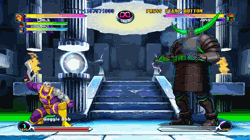 Abyss is the only original boss in the Capcom Versus franchise. Sometimes we get a giant baddy (Apocalypse, Onslaught, Galactus, whatever was that thing from Okami) or an “augmented” version of an established villain (Cyber Akuma, Ultron-Sigma), but Abyss was the only 100%, does-not-appear-in-any-other-game-in-any-form final boss of a Versus title. And this makes sense, as Marvel vs. Capcom 2 was the only Versus game to prominently feature original characters, too. In retrospect, it is abundantly obvious that the likes of Ruby Heart and Amingo would be fighting the similarly original Abyss.
Abyss is the only original boss in the Capcom Versus franchise. Sometimes we get a giant baddy (Apocalypse, Onslaught, Galactus, whatever was that thing from Okami) or an “augmented” version of an established villain (Cyber Akuma, Ultron-Sigma), but Abyss was the only 100%, does-not-appear-in-any-other-game-in-any-form final boss of a Versus title. And this makes sense, as Marvel vs. Capcom 2 was the only Versus game to prominently feature original characters, too. In retrospect, it is abundantly obvious that the likes of Ruby Heart and Amingo would be fighting the similarly original Abyss.
And I very deliberately say “in retrospect”, because, back when MvC2 was released in 2000, my friends and I went nuts trying to find the origin of Abyss.
This was not unprecedented! Onslaught, the boss of Marvel vs. Capcom (1), was a complete unknown to my social circle when we first cleared that game. Sure, Evil Professor X was the basis of one of the most infamous Marvel crossovers of all time, but his alter ego had not appeared in any other X-Men media (like the animated series). Thus, we had to rely on comics, and the local comic book store was… let’s just say it was not all that inviting if you were not one of three 40 year old men that had been there when the place opened. So we learned the backstory of Onslaught from sources online, and said sources were primarily Geocities fansites that had recently mastered creating character thumbnails. Think reading a wiki is boring? Well try doing it on a website that is also playing an endless MIDI of the X-Men theme and tossing far too many GIFs at you. …. Uh… not that there’s anything with a website using a lot of GIFs….
But Abyss was a complete unknown. From what our intrepid research could discover, Abyss was either some kind of monster from an alternate Marvel universe involving Havok (the then current Mutant X comic), something out of the Age of Apocalypse crossover (had ended by that point, but was already fairly legendary), or possibly the last boss of a Capcom arcade fighting game that involved a lion-man (hello again, Red Earth). And there was also supposition thanks to its moves and abilities that it may have existed somewhere else, but was somehow not logged online. Its final form looks like Venom, so is it some kind of Carnage upgrade? Or was its Armor-based existence a reference to a Ghouls ‘n Ghosts final boss we were never good enough to battle? Abyss was, of course, none of these things, and was simply an original villain that was little more than a thing for Cable to hit. “Abyss is an enchanted treasure that is slowly destroying the world” was not the answer we were looking for, though, so we kept looking.
And that is kind of amazing. In a game that features 56 iconic characters from across mediums and generations, Abyss held our imaginations. It (He? She? They? Let’s stick to “it” as it is technically a magical object) was little more than a tech demo wrapped in some minotaur-appropriate attire, and we had to know more. And, in trying for this prize that would never come, we learned about characters from comics. We learned about other videogames. We learned about all sorts of characters from all sorts of origins and backgrounds, and we were better for it. From Akuma to Marrow to Zangief, we absorbed any information and morals these fighters could provide. It wasn’t enough to “main” Psylocke, we had to know all the good and bad that came with that character, too. It was all a result of staring into Abyss, and a whole lot more than that final boss staring back.
And, yeah, something like that makes a bit of an impact.
So thank you for everything Marvel vs. Capcom 2. In the same way that Abyss could be much more than an original, one-off boss, you were always so much more than a fighting game.
FGC #600 Marvel vs. Capcom 2: New Age of Heroes
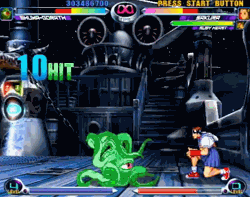 System: Started in the arcade, and moved to the Sega Dreamcast for the most accurate home port. We got a physical release on Xbox and Playstation 2, and then a digital version on Xbox 360 and Playstation 3. Haven’t seen the poor girl since.
System: Started in the arcade, and moved to the Sega Dreamcast for the most accurate home port. We got a physical release on Xbox and Playstation 2, and then a digital version on Xbox 360 and Playstation 3. Haven’t seen the poor girl since.- Number of players: Marvel vs. Capcom 1 had a rad 4-player mode, though we are sticking to two players controlling six total fighters at a time.
- Port-o-Call: The later ports of MvC2 get a lot right with having everything unlocked to start, so you can take someone for a ride with Spiral as quickly as possible. But the most arcade accurate port seems to still be the Dreamcast version. Widescreen is fun, kiddies, but it can make a few differences in gameplay…
- Just play the gig, man: The best part of the Marvel vs. Capcom 2 soundtrack is the entirety of the Marvel vs. Capcom 2 soundtrack.
- Maybe actually talk about the game for a second: This is everything I want out of a fighting game. Variety. Expressions. At least one giant zombie. It is unbalanced as all get out, but danged if it isn’t fun. And I can have a new team every time I play! Over a million possible combinations! There is a reason I played this forever with my peer group back in the late 20th Century.
- Modes of Play: I have logged twelve billion hours in Marvel vs. Capcom 2 for the Sega Dreamcast. I have never even tried Score Attack mode.
- Favorite Team: Let’s see here… Juggernaut for a dude that has an arm longer than most opponents, Cable for the gun-fu and beams, and… let’s see here… from the Capcom side, I’ll choose Mega Man. I am not any good with Mega Man, but he is Mega Man, so he gets a slot.
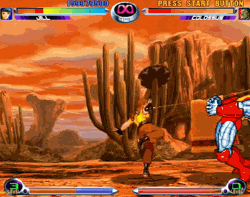 The Actual Best Team: I do not care for Storm or Magneto (as playable characters, they seem like okay people otherwise). Sentinel I enjoy because it is huge, so I only really like playing as 33% of the “best” characters in Marvel vs Capcom 2. Cable, though…
The Actual Best Team: I do not care for Storm or Magneto (as playable characters, they seem like okay people otherwise). Sentinel I enjoy because it is huge, so I only really like playing as 33% of the “best” characters in Marvel vs Capcom 2. Cable, though…- What Could Have Been: Technically, Marvel vs. Capcom 2 contains every “real” playable character that had appeared in the franchise up to that point. However, there were a number of color swaps, clones, and cyborgs that wound up on the cutting room floor. Shadow Charlie, Shadow Lady Chun-Li, Lilith-Morrigan, Red Venom (Carnage), Orange Hulk (Thing), and Golden War Machine (Drunk Iron Man?) are no big loss. Anita and Norimaro could have shown their faces, though. Norimaro is a clear ancestor to MvC3 Deadpool, too! As least Mecha Zangief and Sunburnt Sakura sneak in under the wire as activated “moves”.
- What Could Have Also Been: Jubilee has a sprite as an assist character in Marvel vs. Capcom (1), so she really should have been upgraded to playable (US Agent, a Captain America color swap, is the only other Marvel assist that is not playable in MvC2). The Capcom assists are a lot more esoteric, but who could say no to Pure & Fur being more conspicuous?
- Come to think of it: Capcom needs to free Marvel vs. Capcom 2, but you know what? Somebody at Capcom just go ahead and make a Marvel vs. Capcom 2.5. Include the “dropped” hidden characters. Include MvC Ryu and his form changes. Add some “demake” sprites to simulate Marvel vs. Capcom 3 additions (and Infinite, I guess). Include the “3 of one character” Dreamcast feature. Add unique endings. Give me, personally, a million dollars. I mean, if wishes are horses here already…
 Goggle Bob Fact: This was the first game where I ever “downloaded a save” to immediately unlock all of the characters. My friends and I did successfully unlock everyone the real way on a friend’s VMU, but I couldn’t very well copy his data, could I? That was a unique and perfect encapsulation of our playtimes together! Let me just check Gamefaqs so I can download the concept of effort…
Goggle Bob Fact: This was the first game where I ever “downloaded a save” to immediately unlock all of the characters. My friends and I did successfully unlock everyone the real way on a friend’s VMU, but I couldn’t very well copy his data, could I? That was a unique and perfect encapsulation of our playtimes together! Let me just check Gamefaqs so I can download the concept of effort…- Did you know? There are four new characters in Marvel vs. Capcom 2. Son-Son and Ruby Heart are women. Amingo is a cactus that can reproduce asexually (actively, and during battle). And Abyss is a sentient orb. So there technically are no original, male characters. Hooray?
- Saddest Did you know? Breath of Fire has always been ignored in the Versus franchise. This is because we do not live in the same universe as a caring, loving God.
- Would I play again: Ultimate Marvel vs. Capcom 3 is the better balanced, most fair fighting game. Marvel vs. Capcom 2 is pure fun, though. I enjoy pure fun.
What’s next? Random ROB has chosen… Psychonauts 2! We are going to lose our minds venturing into various minds! Please look forward to it!
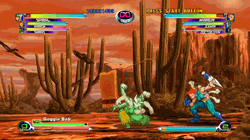
Dang, I love this move
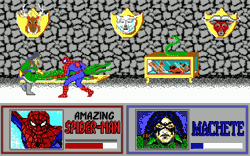
[…] is barely even acknowledged on anything but the box copy. Beyond that, this is a story starring Tron Bonne and her family (characters introduced exclusively for Mega Man Legends) before they encountered our […]